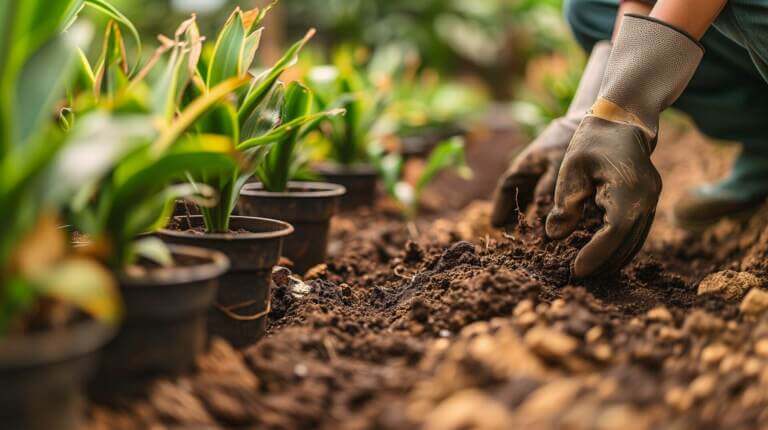How to Repot a Snake Plant: When and How to Repotting Snake Plant To A Bigger Pot.
Are you tired of your snake plant outgrowing its pot? Repotting can give your snake plant fresh soil and room to grow. Learn when and how to repot a snake plant for a healthy, thriving succulent.
We’ll cover signs your snake plant needs repotting, the best time of year, soil recommendations, step-by-step instructions, and tips for dividing snake plants. With the right technique, repotting snake plants is easy. Follow this guide for happy snake plants and new plants from divisions.
Key Takeaways
- Signs that your snake plant needs repotting include tightly packed roots, roots coming out of drainage holes or growing on the soil surface, yellowing or drooping leaves, slow growth, and nutrient deficiencies or root rot due to overcrowded roots.
- The right time to repot your snake plant is every 1-2 years or when it becomes root-bound. Other signs include roots coming out of the pot, slow growth, water drainage issues, foul odor from the potting mix, and cracking pot due to expanding roots.
- Necessary supplies for repotting include a slightly larger pot with good drainage, a well-draining soil mixture of potting soil, perlite, and sand, gardening gloves for protection, a trowel for scooping soil, and a watering can or spray bottle for watering the plant.
- The step-by-step guide to repotting your snake plant includes filling the new pot with well-draining potting mix, gently removing the plant from its current container and trimming any damaged roots, placing the plant in the new pot at the same level, filling gaps with fresh potting mix, and securing the plant.
Signs That Snake Plant Repotting Is Necessary
Does your snake houseplant need repotting? Look for these signs: Roots emerging from the bottom of the pot such as the drainage holes mean your snake plant is pot bound. Repotting gives the roots more room. Circled, crowded roots that strangle each other also indicate it’s time for a larger pot. Snake plants outgrowing their pots may show signs of stress like yellow, drooping leaves. They need more space for the root to thrive.
Root bound snake plants should get moved to a pot one size larger in spring. Use a well-draining cactus/succulent soil mix and gently loosen the roots first. Repotting yearly isn’t necessary, but your snake plant will benefit when properly pot bound. With more room, it will reward you with vigorous growth.
Choosing the Right Time to Repot Snake Plants
A crucial aspect of successfully repotting your snake plant is determining the optimal time and conditions to undertake this task. Knowing when to repot your snake plant is essential for its overall health and growth. Typically, snake plants need to be repotted every 1-2 years or when they have become root-bound.
To help you determine the best time to repot your snake plant, here is a table outlining the signs that indicate it is time for repotting:
- Roots coming out of the pot When you notice the roots growing out of the drainage holes, it’s time to repot.
- Slow growth If your snake plant’s growth has significantly slowed down, it may need a bigger pot.
- Water drainage issues If the water doesn’t drain properly, it could indicate that the roots are overcrowded.
- Foul odor A foul smell coming from the potting mix could indicate root rot, requiring repotting.
- Bursting pot When the pot starts to crack due to the expanding roots, it’s time for repotting.
Gathering the Necessary Supplies for Repotting
Before repotting your snake plant, gathering all the necessary supplies within a suitable timeframe is crucial to ensure a smooth and efficient process. One of the first steps in preparing for repotting is choosing the right size pot. The pot should be slightly larger than the current pot, allowing room for the snake plant to grow and expand its roots. It is important to avoid using too large pots, as this can lead to overwatering and root rot.
In addition to the pot, you will also need to prepare the potting mix. Snake plants prefer well-draining soil, so it is recommended to use a mixture of potting soil, perlite, and sand. This will help prevent waterlogged roots and promote healthy growth.
You will also need gardening gloves to protect your hands, a trowel for scooping the soil, and a watering can or spray bottle for watering the plant after repotting. Having a clean work area and a drop cloth or newspaper is also helpful to catch any soil or debris.
Step-by-Step Guide to Repotting Your Snake Plant
To begin repotting your snake plant, carefully lift the plant out of its current container, gently loosening the roots and ensuring minimal damage. Choosing a slightly larger pot with good drainage is important to accommodate the plant’s growth. Here is a step-by-step guide to repotting your snake plant:
- Prepare the new pot by filling the bottom with a well-draining potting mix, leaving enough space for the plant’s root ball.
- Carefully remove the snake plant from its current container, gently shaking off excess soil. Inspect the roots for any signs of disease or rot, and trim any damaged or dead roots.
- Place the plant in the new pot, ensuring that it sits at the same level as before. Fill in the gaps with fresh potting mix, gently pressing it down to secure the plant.
Here are some common problems and mistakes to avoid when repotting snake plants:
| Repotting Mistakes to Avoid | Common Problems when Repotting Snake Plants |
|---|---|
| Using a pot without drainage holes: This can lead to waterlogged soil and root rot. | Overwatering: Snake plants prefer to dry out between waterings. |
| Using heavy, compacted soil: Poor drainage can suffocate the roots. | Insufficient light: Snake plants require bright, indirect light to thrive. |
| Repotting too often: Snake plants prefer to be slightly root-bound. | Dry indoor air: Low humidity levels can cause leaf browning and curling. |
Gathering the Necessary Supplies for Repotting
Before repotting your snake plant, gathering all the necessary supplies within a suitable timeframe is crucial to ensure a smooth and efficient process. One of the first steps in preparing for repotting is choosing the right size pot. The pot should be slightly larger than the current pot, allowing room for the snake plant to grow and expand its roots. It is important to avoid using too large pots, as this can lead to overwatering and root rot.
In addition to the pot, you will also need to prepare the potting mix. Snake plants prefer well-draining soil, so it is recommended to use a mixture of potting soil, perlite, and sand. This will help prevent waterlogged roots and promote healthy growth.
You will also need gardening gloves to protect your hands, a trowel for scooping the soil, and a watering can or spray bottle for watering the plant after repotting. Having a clean work area and a drop cloth or newspaper is also helpful to catch any soil or debris.
Step-by-Step Guide to Repotting Your Snake Plant
To begin repotting your snake plant, carefully lift the plant out of its current container, gently loosening the roots and ensuring minimal damage. Choosing a slightly larger pot with good drainage is important to accommodate the plant’s growth. Here is a step-by-step guide to repotting your snake plant:
- Prepare the new pot by filling the bottom with a well-draining potting mix, leaving enough space for the plant’s root ball.
- Carefully remove the snake plant from its current container, gently shaking off excess soil. Inspect the roots for any signs of disease or rot, and trim any damaged or dead roots.
- Place the plant in the new pot, ensuring that it sits at the same level as before. Fill in the gaps with fresh potting mix, gently pressing it down to secure the plant.
Here are some common problems and mistakes to avoid when repotting snake plants:
Repotting Mistakes to Avoid Common Problems when Repotting Snake Plants
- Using a pot without drainage holes: This can lead to waterlogged soil and root rot.
- Overwatering: Snake plants prefer to dry out between waterings.
- Using heavy, compacted soil: Poor drainage can suffocate the roots.
- Insufficient light: Snake plants require bright, indirect light to thrive.
- Repotting too often: Snake plants prefer to be slightly root-bound.
- Dry indoor air: Low humidity levels can cause leaf browning and curling.
Tips for Caring for Your Transplanted Snake Plant
Repotted snake plants need extra care as they adjust to their new pots. Allow the soil to dry out more between waterings, as too much moisture can cause root rot. Snake plants prefer drier conditions. Inspect for pests like spider mites, which may attack after repotting. Place in bright, indirect light to support growth.
It’s normal for repotted snake plants to be stressed or grow slower initially. Avoid fertilizing for a few weeks until the roots recover. Then, resume fertilizing in spring and summer to nourish your snake plant in its larger pot. Monitor for signs of shock like wilting or yellow leaves. With proper aftercare, your snake plant will thrive in its new home.
FAQ
What is the Ideal Pot Size for a Snake Plant to Allow for Maximum Growth?
Snake plants, known for their resilience, can thrive in various pot sizes, but selecting the ideal one is crucial for maximum growth. To answer the question “how tall can snake plants grow,” it’s important to note that they typically reach a height of 2-4 feet indoors. Choosing a pot that accommodates their mature size while providing ample root space is essential for promoting their growth and overall health.
Will Repotting My Snake Plant Help Revive a Drooping Sansevieria?
Repotting is a beneficial measure for reviving a drooping snake plant. By transferring it to a fresh pot with fresh soil, you can enhance drainage and provide the plant with essential nutrients. This process promotes healthy root growth, ultimately reviving the plant and improving its overall appearance.
When Should I Propagate My Snake Plant Instead of Repotting It?
When should I propagate my snake plant instead of repotting it? If your snake plant is struggling to grow or its roots are crowded, it might be time to consider propagating it. Propagation can be done using various rooting snake plant tips such as dividing the plant, rooting leaf cuttings in water, or division through offsets. By propagating, you can give your snake plant a fresh start and ensure healthier growth.
How Long Does It Take for a Transplanted Snake Plant to Adjust to Its New Pot?
After being transplanted, a snake plant may take several weeks to adjust to its new pot. Signs of a healthy transplanted snake plant include new growth, stable foliage, and absence of wilting or discoloration, indicating successful transplant shock recovery.
How often do snake plants need to be repotted?
Snake plants can be repotted sparingly. They are slow-growing and can stay in the same pot for several years.
What is the best soil for snake plants?
Snake plants prefer well-draining soil. A mix of potting soil, sand, perlite, or a cactus/succulent soil mix would work well.
Can I repot my snake plant in a plastic pot?
Yes, you can repot your snake plant into a plastic pot. Just make sure it has drainage holes to prevent water from sitting at the bottom.
How do I repot a large snake plant?
To repot a large snake plant, gently loosen the plant from its current pot, remove it, and place it in a larger pot with fresh soil. Make sure to firm the soil around the base of the plant.
Can I propagate snake plants by repotting?
Yes, you can propagate snake plants by repotting the plantlets or pups that grow from the base of the main plant into separate pots.
When is the best time to repot a snake plant?
The best time to repot a snake plant is in the spring, just before the growing season begins. This will give the plant enough time to establish its new roots.







